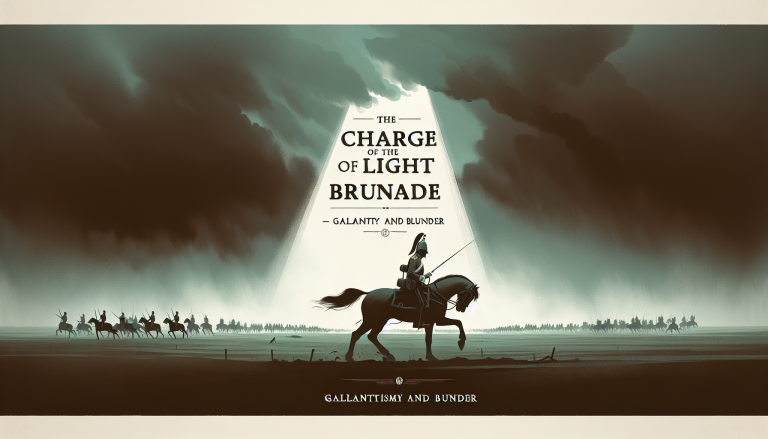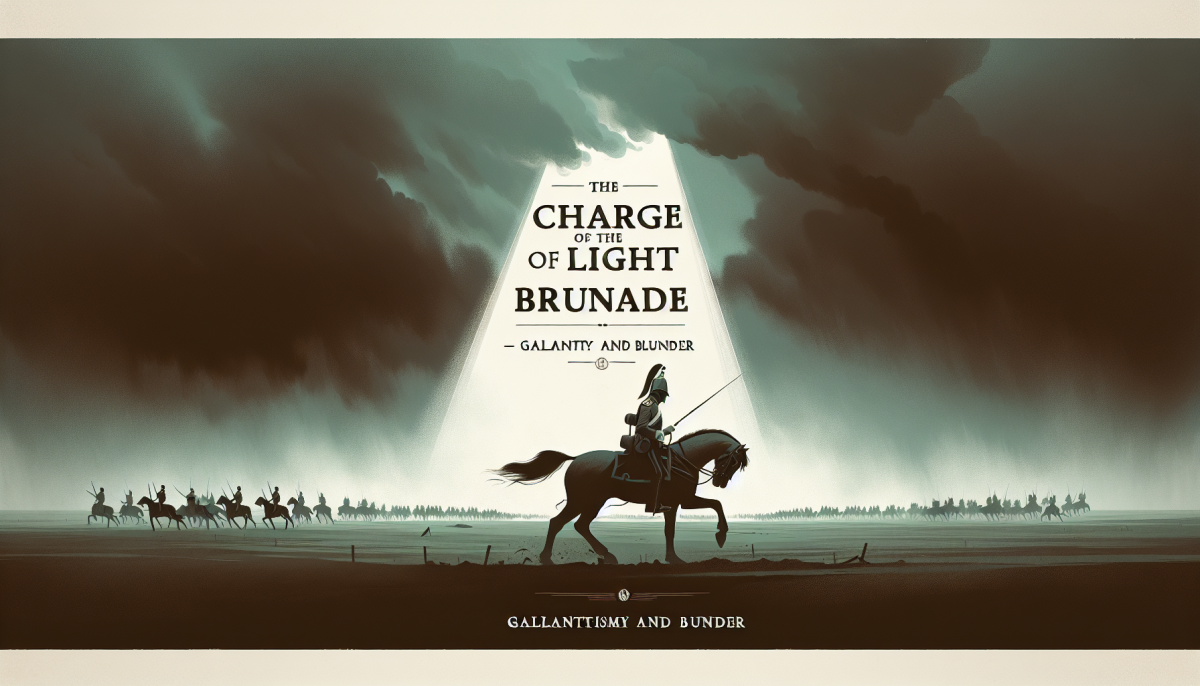The Charge of the Light Brigade: When Futility Galloped into History
Imagine if you will a group of brave soldiers, spurs shining, hearts aflame with valor—and charging headlong into a situation so utterly doomed that even the horses might have stopped mid-gallop to file a complaint. Welcome to the Charge of the Light Brigade, the 1854 military blunder so famously futile that it has become synonymous with “beating a dead horse.” Except, in this case, the horse was very much alive and kicking but poor luck for it, the entire brigade was headed straight into a hailstorm of bullets instead of glory.
The scene is the Crimean War, a delightful cocktail mix of mud, cannons, and diplomatic squabbles between Britain, France, the Ottoman Empire, and Russia. Or as history would rather remember it: the war where communication went spectacularly bad and nobody was quite sure who should be shooting whom. In this chaos, the Light Brigade—a group of light cavalry, the military equivalent of sprinters hoping for a smooth track—found themselves assigned a “special mission.”
The Tale of a Terrible Telegraph
The orders given were a masterpiece of muddle. Lord Raglan, the British commander, wanted the Light Brigade to prevent Russian forces from removing captured guns. Simple enough, right? But through a game of military telephone, the message got twisted. The Light Brigade received instructions to charge directly into the main Russian artillery rather than the cannon capture attempt. “The guns are ours!” one might cheer. “So, let’s go smash those cannon!” shouted the other. Yet what ended up happening was more akin to *“Go ride straight into an artillery fortress with minimal cover and see if you can survive.”*

The cavalry commander, Lord Cardigan, enthusiastically obeyed, perhaps misunderstanding the order, or maybe just eager to avoid the awkward “I didn’t quite catch that” moment in front of his men. The result? Around six hundred men, sabers flashing and horses hoofing at breakneck speed, stormed headlong into a hail of artillery and rifle fire.
Futility in Full Gallop
Now, here’s where the phrase “beating a dead horse” reaches full throttle. The Light Brigade charged, got hit, made a sort of tactical slapstick laughable only in hindsight, and limped back with heavy casualties. The mission was impossible, the order unclear, and the outcome tragic but, let’s face it, historically hilarious (in the cruelest sense).
Turn back to the horses for a moment. These poor beasts, charged without much to gain besides being cannon fodder, embodied a metaphorical dead horse when it came to the military objective—a noble effort that was about as effective as throwing a teabag into the ocean to reclaim the British Empire.
The phrase “beating a dead horse” couldn’t fit better. This wasn’t a case of persistent effort paying off through grit and determination. No, this was the military equivalent of someone furiously flailing their arms to revive a horse that had run face-first into a cannonball.
Lord Tennyson’s Poetic Tribute to the Blunder
As if the event weren’t pitiful enough, the British public immortalized this blunder in Alfred, Lord Tennyson’s poem, *The Charge of the Light Brigade.* The poem’s gallantry praises the soldiers’ courage but also subtly laments the futility of their charge:
“Into the valley of Death
Rode the six hundred.”
Here, “Death” isn’t a metaphor—it’s an accurate location. The poem captures the tragic bravery but leaves every reader wondering: “What on Earth were they thinking?”
Tennyson’s poem might be the Victorian era’s finest example of using high art to console a nation traumatized by a blunder worthy of a Monty Python sketch. The image of men being “noble in their blindness” sums it up perfectly: brave men, misdirected, charging into certain doom because of a clerical disaster on the battlefield.
The Cavalrymen’s Last Ride… Literally
The Light Brigade was a tight-knit group; many men rode with their lives on the line, not receiving fresh orders during the chaos, essentially turning into a literal “beating of a dead horse”—a waste of energy, lives, and horse feed. After the charge, a mere two hundred men walked out of the valley of Death. The rest left as permanent tenants of the battlefield.
Lord Cardigan, who led the charge, survived but was criticized for either gross incompetence or blind obedience. His defense? He followed orders, which is hilarious if you consider how those orders were crafted: a hopeless mix of ambiguity and poor communication that spawned a historical gag worthy of satirists.
Political and Military Aftershocks: A Campaign to Forget
One could imagine the war room post-charge: generals furiously pointing fingers while others tried to erase the entire row of messages on telegraph paper. Official reports danced delicately around the fact that this heroic charge was, in reality, a tragic circus act. British command quickly realized the intelligence flaw here was more dodgy than their soldiers’ escape routes.
This blunder not only earned the Light Brigade a place in history but effectively turned the Crimean War into a “how not to” manual for generals. For example, ignoring the virtues of clarity might as well be tattooed on every dispatch officer’s forehead: *“If your order requires a decoder ring, it’s probably a mistake.”*
The Charge of the Light Brigade also became a linguistic gift. To this day, when someone is “beating a dead horse,” history fans with a wicked sense of humor picture six hundred cavalrymen charging into a tangled mess of artillery fire, galloping under a hailstorm of bullets, doing their utmost best to get nowhere useful.
Satire and the Dead Horse: The Charge as Cultural Meme
Cartoonists and satirists have had a field day. Political cartoons from the late 19th and 20th centuries gleefully depicted generals literally lashing dead horses, prompting viewers to nod knowingly—because nothing says futile effort quite like watching someone physically and metaphorically trying to revive a creature long past its prime, in a situation doomed from the start.
One can’t help but chuckle imagining a Victorian-era cartoon: a fleet of helmeted officers wielding comically oversized whips against an indifferent steed, the horse just blinking and chewing, utterly unimpressed. It’s a perfect indictment of stubbornness and futility, a lesson echoed in countless modern-day “too much effort, too little result” scenarios.
Legacy of the Light Brigade: Futility Enshrined in Fame
Despite the tragedy, the Light Brigade didn’t fade into obscurity. Instead, it galloped straight into the annals of history as the quintessential example of a “futile” endeavor that turned deadly because of miscommunication and overly zealous obedience.
Military historians still study it as a case of how not to plan an attack; poets lament its bravery shadowed by futility; comedians and satirists enjoy endless material on the absurdity of a cavalry charge into an artillery trap. It’s a timeless reminder that sometimes, no matter how hard you beat a dead horse, it’s not going to get up and march off to victory.
The Charge of the Light Brigade is the perfect historical embodiment of futile efforts, a blunder so spectacular it transcended tragedy, becoming a metaphor—an immortal dead horse—that continues to be beaten, loudly and humorously, through the ages.
